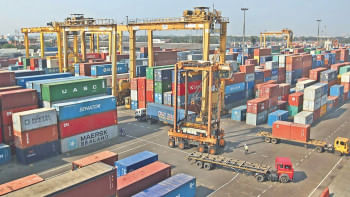Wanted for RMG industry: Ghost busters

Like most people whenever I hear talk of “conspiracy theories” I disregard the rest as it has become the most used and abused excuse for all our ills, be they political, social or economic. Exhorting the people to resist the evil designs of “foreign powers or aliens” has been the most popular diversionary tactic used by our leaders. I confess therefore that I have always been highly sceptical about the conspiracy theories floated by our garments industry from time to time as an explanation for the random and increasingly frequent violence plaguing their industry. But the specific events of Diganta Sweaters that occurred a few weeks ago have changed my point of view. I watched at great length the innumerable news reports and talk shows that day and read also many of the newspaper reports on the same.
The “facts” are, as they emerged:
*The factory employs several thousand workers producing sweaters for export in a huge multi storied factory complex in Gazipur.
*The company seemed to be quite well regarded by the workers as a fair and good employer, with no issues regarding nonpayment of wages, bonuses and overtime, which are the most common roots of discontent in such factories.
*The trouble started when rumours started that a particular bathroom on the fifth floor was haunted and some unnamed workers had been seen to enter the same in good health and emerge mauled and bloodied. One or more of these victims were rumoured to have actually died as a result and it was alleged that the management then smuggled out the bodies in gunny bags to avoid detection. Some eagle-eyed workers had spotted this and immediately went up the battle cry of “return us the bodies”.
*Another woman worker described how she had witnessed two bodies “floating” out of the same bathroom and then had herself fainted, to a TV channel.
Net result: Ten factories in that area attacked and damaged over a 48 hour period, 100 people injured including police, cars burnt, roads blockaded and four factories closed down. I watched in disbelief, as the senior police officer on the spot described his inability to “apprehend these spirit” on live prime time TV.
Finally when on a live call in TV show, a viewer advised the senior BGMEA leader to engage an exorcist and bring to justice those evil conspirators that had released these spirits in the first place, I had to ask: have we lost all rationality and sanity?
Why was there not a single attempt by the police, local administration or even the factory to take a TV crew into that bathroom and actually disprove these claims? Even a layman such as I could see from the wildly contradictory and inconsistent stories by “witnesses” that reason had left the building and mob hysteria ruled the day.
The industry leaders have repeatedly claimed that they have evidence of “outside” interests including foreigners, NGOs, fake trade union activists provoking such anarchy. They have also claimed that the government intelligence agencies have identified these agent provocateurs but are not acting. The workers have claimed that they have evidence that their co-workers have been assaulted and even killed.
What is preventing the government to conduct a proper and credible investigation of such incidents and then announce the findings to the public, workers, management and local authorities?
We all condemn the few irresponsible and exploitative garment factory owners but we must also laud the majority of hard working entrepreneurs who have transformed Bangladesh. Beyond the statistics (76 percent of our export earnings, two million directly employed, 80 percent women) are the intangibles: how they have helped put Bangladesh on the map, how “Made in Bangladesh” has replaced “Aid for Bangladesh”, how they have brought millions of young women into the workplace, how they have generated an entire ecosystem of support industries such as packaging and labels, how they have created new consumers for local industries such as cosmetics and cell phones. The multiplier effects of this industry are too numerous to list but my favourite is a small bazaar store in Shafipur Bazaar that makes “compliance signs”.
So then why does this industry still suffer tragedies such as Diganta? I believe the first reason is the too big too fast syndrome where some factories have boosted production capacity rapidly without growing requisite managerial capacity. They have not developed the systems to effectively manage the huge number of people they suddenly employ. The HR function has been simply get more workers and if they leave, get more. In this race to get hands not enough attention is given to the heads and the hearts. Many of these factories started as small unit where there was a direct link between owner and factory, often a shared history. As the factories have grown that link has been broken and owners have become isolated from the shop floor and completely dependent on line managers. But that cannot and should not be an excuse for anarchy and violence.
Which brings us to the second reason. Suffice it to say the next time you see a factory being vandalized on TV, look a little closer and ask yourselves: do those rioters all look like factory workers and would they really destroy their source of livelihood?
Maybe then we can all help exorcise these evil spirits.

 For all latest news, follow The Daily Star's Google News channel.
For all latest news, follow The Daily Star's Google News channel. 



Comments